Three men, one excavation, and a century-old scandal in the mudflats of southern Iraq
The story of the University of Pennsylvania’s late-19th-century excavations at Nippur in Iraq sounds more like the plotline for a reality TV show—complete with alliances, betrayals, and tabloid fodder—than the academic pursuit of knowledge about an ancient civilization. But Philadelphia’s Penn Museum isn’t afraid to tell the messy tale in the exhibition “Archaeologists & Travelers in Ottoman Lands,” which offers insight into the nascent days of American archaeology. On view are artifacts excavated from the site, photos of the dig, two unique paintings, and the paper trail left behind by the drama’s leading men: Osman Hamdi Bey (1842–1910), who granted the excavation permit to dig at Nippur and later divvied up the finds; John Henry Haynes (1849–1910), who discovered more than 24,000 cuneiform tablets over a decade of work at the site; and Hermann Vollrath Hilprecht (1859–1925), who egregiously took credit for the whole thing.
Hilprecht was a Penn professor, Assyriologist, and ordained minister. “Penn got interested in archaeology basically through the likes of people like Hilprecht,” says exhibition curator Robert G. Ousterhout. “They were interested not so much in the sphinxes and Egypt and mysterious cultures, but in texts—and in learning the texts of Mesopotamia.” In fact, the goal of the expedition to Nippur, an important Mesopotamian religious center, was to provide “scientific proof” of the Bible by uncovering cuneiform tablets that could produce texts paralleling the Old Testament. Getting permission to dig at the site proved to be the first of many challenges the university was to face.
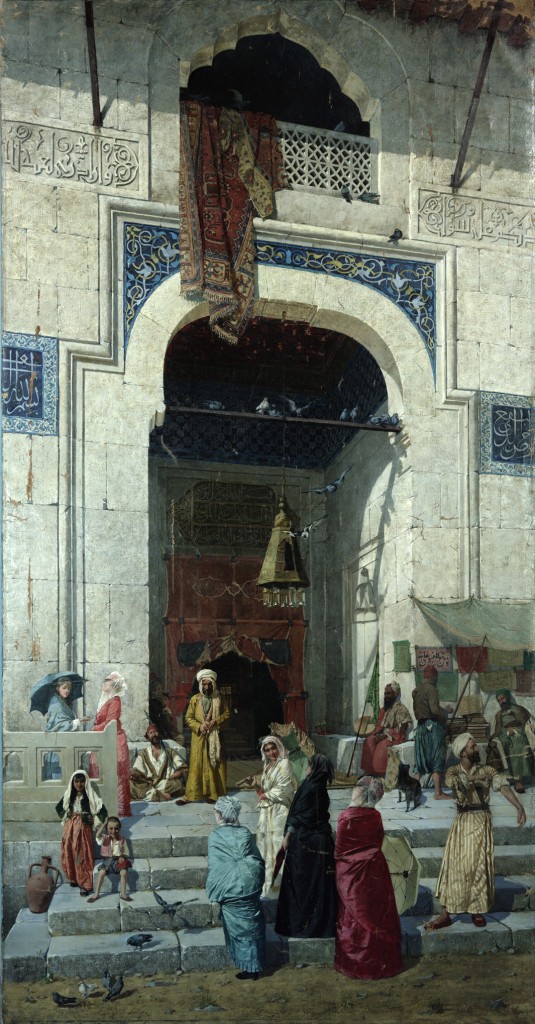
At the Mosque Door (1891) by Osman Hamdi Bey
Enter Osman Hamdi Bey: A French-trained Orientalist-painter-turned-archaeologist, Hamdi Bey was the founder of Istanbul’s archaeological museum and, for all intensive purposes, the gatekeeper of archaeology in the Ottoman Empire. Everyone seemed to know that the quickest way to his heart was through his art. So the University of Pennsylvania arranged for two paintings by Hamdi Bey to come to America, to be exhibited at the 1893 Columbian Exposition in Chicago, and, ultimately, to be purchased by the university. One of these works, At the Mosque Door, hangs at the entrance to the exhibition. As part of the process of preparing the show, the painting, which had been rolled up in the back of the museum’s archives, was restored and re-stretched. “It looks nothing like its original form,” notes Ousterhout. “It was scratched, there were tears in it. It had been cut off the frame.”
The French snatched up the other work from a Paris exhibit before it could even be shipped to America. “Everyone was sort of out playing the same game to flatter Hamdi Bey as an artist, exhibit his paintings, and get their entrée into the antiquities of the Turkish Empire,” says Ousterhout. Also on view are letters in which the University of Pennsylvania offered Hamdi Bey an honorary doctorate, as well as the correspondence among the officials of the university, deliberating as to whether or not he was of sufficient stature to merit a PhD from the prestigeous institution. As an extra incentive, the university gave Hamdi Bey a certificate for membership in the Archaeological Association of Philadelphia. “So a rather interesting trail here of the Americans dealing with Hamdi Bey in Istanbul,” says Ousterhout. Ultimately, the university’s efforts paid off.
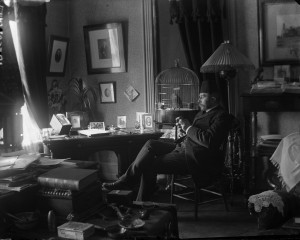
Herman Vollrath Hilprecht in Istanbul, ca. 1895
Cut to Turkey: “Now, for the excavation, possibly the Americans’ greatest tool is not all the paper we see here,” says Ousterhout, pointing to a tidy row of flat-pressed documents lining the narrow gallery’s walls, “but the figure of Hermann Hilprecht who was sort of the ‘evil genius’ behind the whole thing.” Hilprecht positioned himself in Istanbul where he drank tea with Hamdi Bey and hoped to organize the Oriental galleries at the fledgling archaeological museum there. It helped to have Hilprecht at his side.
The new Ottoman antiquities law, as drafted by Hamdi Bey in 1883–84, stated that no antiquities could be removed from Ottoman soil. “He understood how to use the law to his advantage,” says Ousterhout. “It meant that anyone can excavate in the Ottoman Empire—if they play his game.” And those who played it best could be rewarded by having “gifts” bestowed on them in the form of part of the excavated goods. Permit in hand, Penn next had to get to the site.
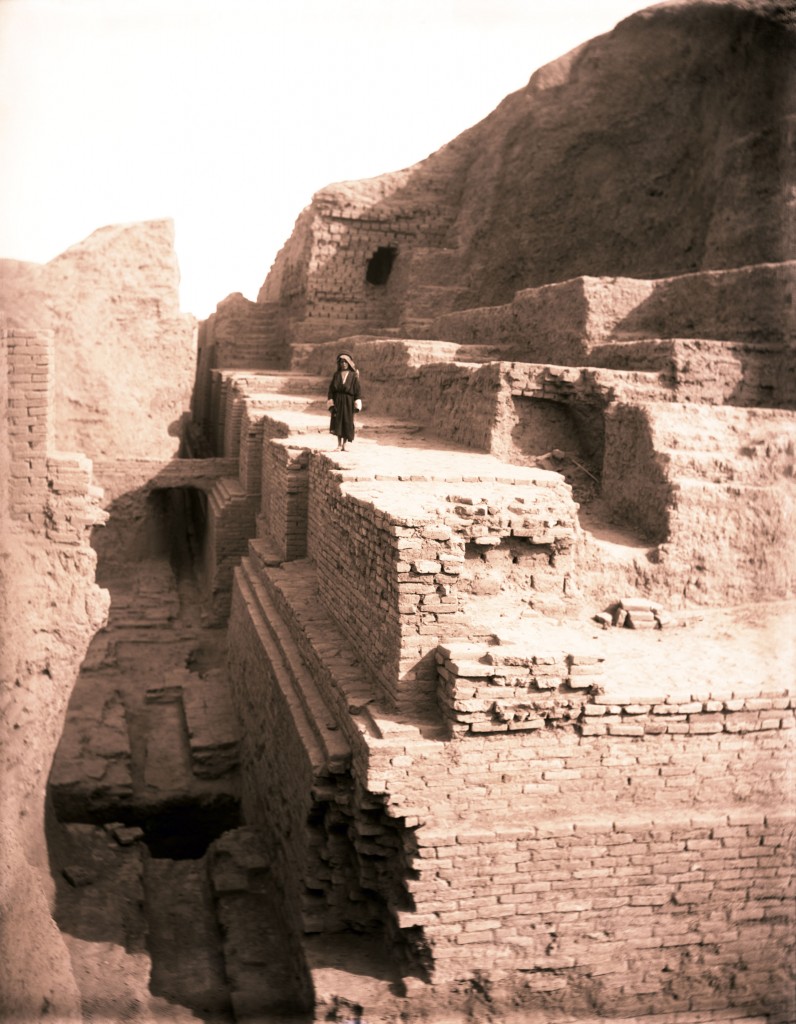
Ziggurat at Nippur by John Henry Haynes (1893-94)
Cue in John Henry Haynes: Haynes was a classical archaeologist who went on the first American excavation at Assos, Turkey, and stayed on in the Ottoman Empire working at Robert College in Istanbul and at the American mission school at Aintab. He was also the first American consul in Baghdad. “He was sort of the man on the ground for the Americans because he knew his way around,” says Ousterhout. “And he was quite an impressive photographer. He is the first person to systematically work as a photographer at an archaeological site, not just show up and take pictures.” Trained by William Stillman, who was known for his important photographs of the Acropolis in Athens, Haynes learned how to frame a photo, use contrasts of dark and light, use a high vantage point to dramatic effect, and open up the landscape he was shooting. Sometimes, he even set up scaffolding to get the right shot. “He understands how to compose a picturesque photograph. But he’s completely unknown,” says Ousterhout, who refers to Haynes as the “father of archaeological photography.” About 50 of Haynes’s photos are in the exhibition, being shown for the first time. “One of the things we’re doing here in this exhibit is resurrect his career.”
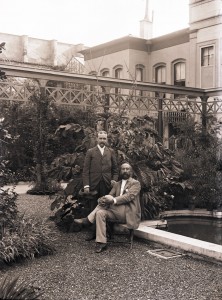
Hamdi Bey with J.P. Peters, 1889
The Dig: Penn’s John Punnett Peters (1852–1921), also an ordained minister, led the Nippur expedition for the first two seasons but simply couldn’t take the conditions at the inhospitable and remote site, located in the swamps of southern Iraq. At the end of the first season, the camp was robbed and burned by warring tribes.
Hilprecht eventually took over as “scientific director” of the excavation—after a fallout withe Peters—but did not return to Nippur, noting his “delicate constitution,” and insisted on directing the dig from the comfort of his offices in Istanbul and Philadelphia, and his home in Jena, Germany. Haynes was then tapped to be the field manager at Nippur. “He’s the only one who was at the site consistently through the entire decade of excavation, from 1889 to 1900,” says Ousterhout.
As a classical archaeologist, Haynes knew what he was doing and could read the inscriptions he unearthed at classical sites. “But in Mesopotamia, it’s dealing with cuneiform texts, which he couldn’t read,” he says. “The only person who could read them was Hilprecht who was back in Istanbul. Haynes is also dealing with a lot of unbaked mud—and so the excavation is not as straightforward. Plus the directions he’s receiving from Hilprecht aren’t straightforward. It’s simply: find more tablets. It’s not: do a systematic, stratified excavation. It’s simply: get to the good stuff and get to it whatever way possible.”
The exhibition features several dozen finds from the site, which were divided between the archaeological museum in Istanbul and the Penn Museum. On view is a tubular Parthian “slipper sarcophagus,” as well as vessels and figurines, including one of a god or man putting his thumb to his nose with his fingers outstretched, a typical Sumerian greeting. “Virtually none of this has been on display before,” says Ousterhout.
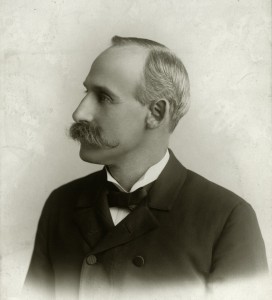
Haynes, ca. 1900
In 1894, Haynes returned to Nippur for a third season to oversee about 90 workmen. “He was quite literally going crazy at the site, writing to Philadelphia regularly saying, ‘Send help, I can’t do this alone,’ ” says Ousterhout. The workmen came from two feuding tribes and so he constantly felt his life was in danger. But that year, he met a young architect in Baghdad, a recent grad from MIT who was traveling on a scholarship, named Joseph Meyer (1856–1894). Looking at the site, Meyer soon realized that there was a city there, and that there was much more besides tablets to be excavated. He also provided much-needed companionship for Haynes.
But within six months Meyer died of dysentery; soon thereafter, Haynes became mentally unbalanced and suffered the first of his mental breakdowns. “He was sent back to the United States at that point for a little R&R, during which, in his ‘weakened condition,’ he married,” Ousterhout says with a chuckle. “His family regarded her as a ‘floozy’ and a ‘gold digger.’ We’re not entirely sure what the story is there. But the last season in the dig house was very interesting. She insisted on coming.” On display is a photo of his bride, Cassandria, being carried in a sedan chair. At the dig house, their marriage fell apart.
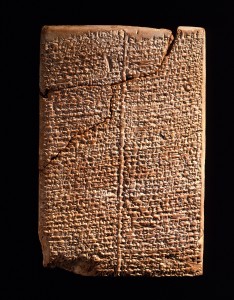
Hymn to the Goddess Inanna, clay tablet from Nippur, ca. 1730 B.C.
In 1900, the final season of excavations, Haynes hit the jackpot—some 24,000 cuneiform tablets—which was at the time thought to be Nippur’s temple library. “What we know, in effect, of Sumerian literature, all comes out of that discovery,” says Ousterhout. Many of the tablets are now known to have belonged to students learning how to operate the stylus and write cuneiform. Students also learned by copying documents, letters, and legal and economic texts; as their skills progressed, they also copied poems, works erotic literature, and classics, including the Epic of Gilgamesh.
Tablets & Tabloids: “What happened in the end was Haynes made the discovery of a lifetime. And Hilprecht decided then it was time to go to the excavation. He arrived, dismissed Haynes as incompetent, took over the excavation, and claimed credit for everything. The headlines that came out of the excavation all credit Hilprecht for an excavation he did in absentia. It finally comes out because he is basically dissing everyone else,” says Ousterhout. Hilprecht claimed that every other excavation paled compared to his—and that he was responsible for everything that came out of the ground at the site. He was rewarded by the university, given a medal, and granted research leave, during which he went on a tour of Europe, lecturing about his great discoveries. (At that point, however, none of the tablets that had been shipped back to Penn had even been unpacked or read.) Haynes, meanwhile, suffered another mental breakdown, entered an institution, and died, forgotten, in 1910; coincidentally, Hamdi Bey died the same year.
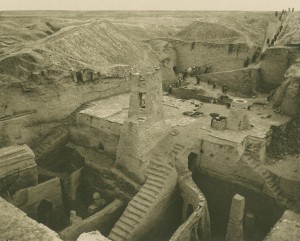
Temple court at Nippur, ca. 1893, photo by Haynes used as the frontispiece of Hilprecht's 1903 book
“I sort of like this,” says Ousterhout, turning from the tablets and walking just a few feet to a wall collage of blown-up newspaper clippings and caricatures of Hilprecht. “The tablets on one side and the tabloids on the other side.” In 1903, Hilprecht published a book called Explorations in Bible Lands during the 19th Century—a copy sits in its own display case—in which he took credit for everything. Hilprecht even used Haynes’s 1893 photograph of Nippur as his frontispiece, but didn’t credit it to Haynes. In the volume, Hilprecht showed his own illustrations, many of which turned out to be pieces from a bazaar in Baghdad! “He’s taken to task by the academic community for what he overstates in the book,” says Ousterhout, “and there’s a tribunal in 1905 that is vicious.” Chief among his critics was Peters.
Protected by his Philadelphia society wife Sallie Crozer Robinson, Hilprecht was found not guilty of “literary dishonesty” by the university. But the scandal never went away and, finally, in 1910—following another incident in which he locked up the tablets at the Penn Museum and took the storeroom keys with him to Europe, leaving inside unpacked crates of crumbling artifacts—he submitted his resignation to the university. “He doesn’t think they will accept it, but they do,” he adds.
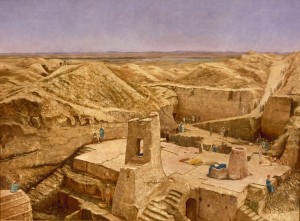
The Excavation at the Temple Court in Nippur (1903) by Hamdi Bey
The Fallout: At the height of excitement about the Nippur discoveries, Hamdi Bey was commissioned by Hilprecht, on behalf of the university, to create a painting for new galleries at the Penn Museum that were planned to tout the finds from the site. Hamdi Bey completed The Excavation at the Temple Court in Nippur in 1903, the same year that the book was published, and is believed to have been created from Haynes’s 1893 frontispiece photograph. Hamdi Bey, however, added a few finishing touches, including Hilprecht on site examining the pottery in the lower right-hand corner of the scene (detail below). “We know from the records of the excavation that Hilprecht was nowhere near this site in 1893,” says Ousterhout. “He was there in 1891 and he was there again in 1900. So he’s actually put in the photograph here, overseeing an excavation when he was nowhere near it!”
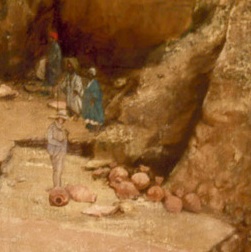
Hilprecht examining pottery at the site
After Hilprecht’s resignation, however, the university turned down the painting and cancelled plans for the new galleries. Hilprecht’s wife purchased the work and the couple took it to their home in Germany where, according to correspondence, it hung in a place of honor. Mrs. Hilprecht’s granddaughter gave it to the Penn Museum in 1948. Neither painting—now valued at an estimated $6–8 million each—has ever been on display at the Penn Museum before.
“The university thought that they were going to get a Nippur gallery out of this,” says says Ousterhout. “What they got was the Nippur scandal.” The tribe had spoken.
“Archaeologists & Travelers in Ottoman Lands” is on view at the Penn Museum through June 26, 2011. An expanded version of the show—with its emphasis shifted onto the Ottoman perspective of watching the Americans come into the empire—will open at Istanbul’s Pera Museum in October.



